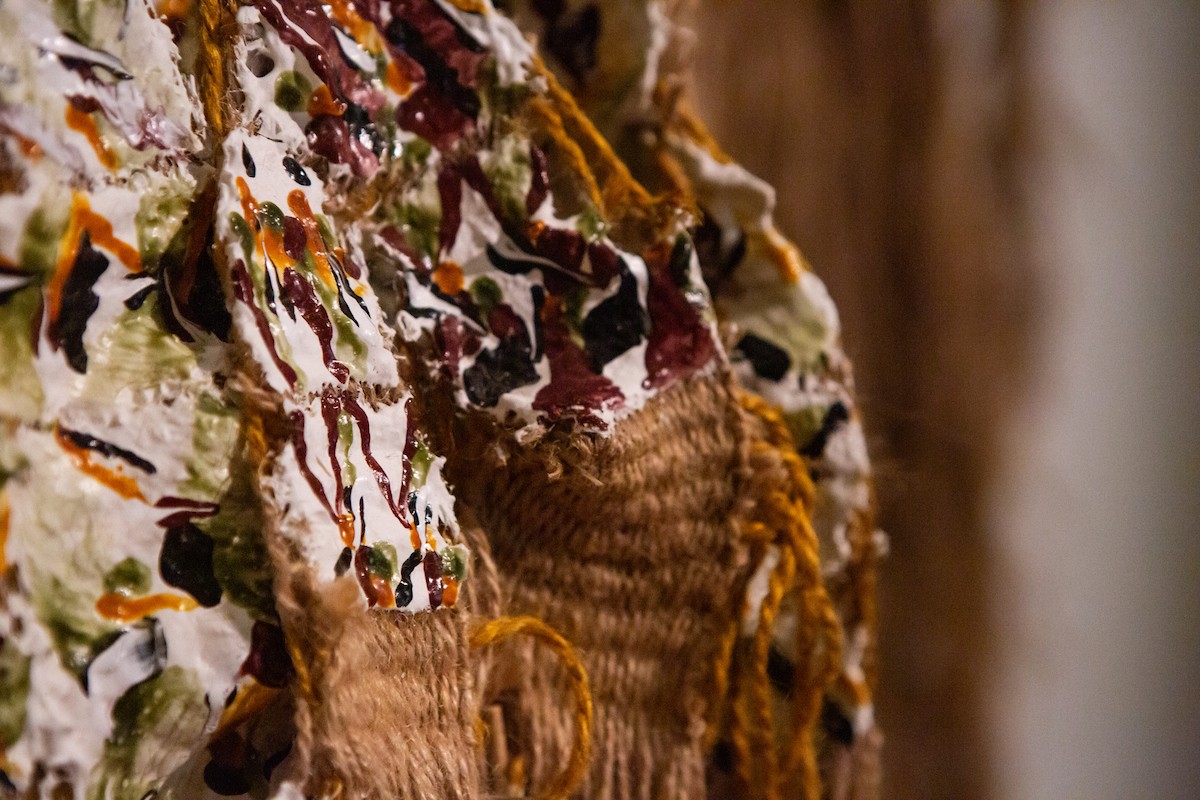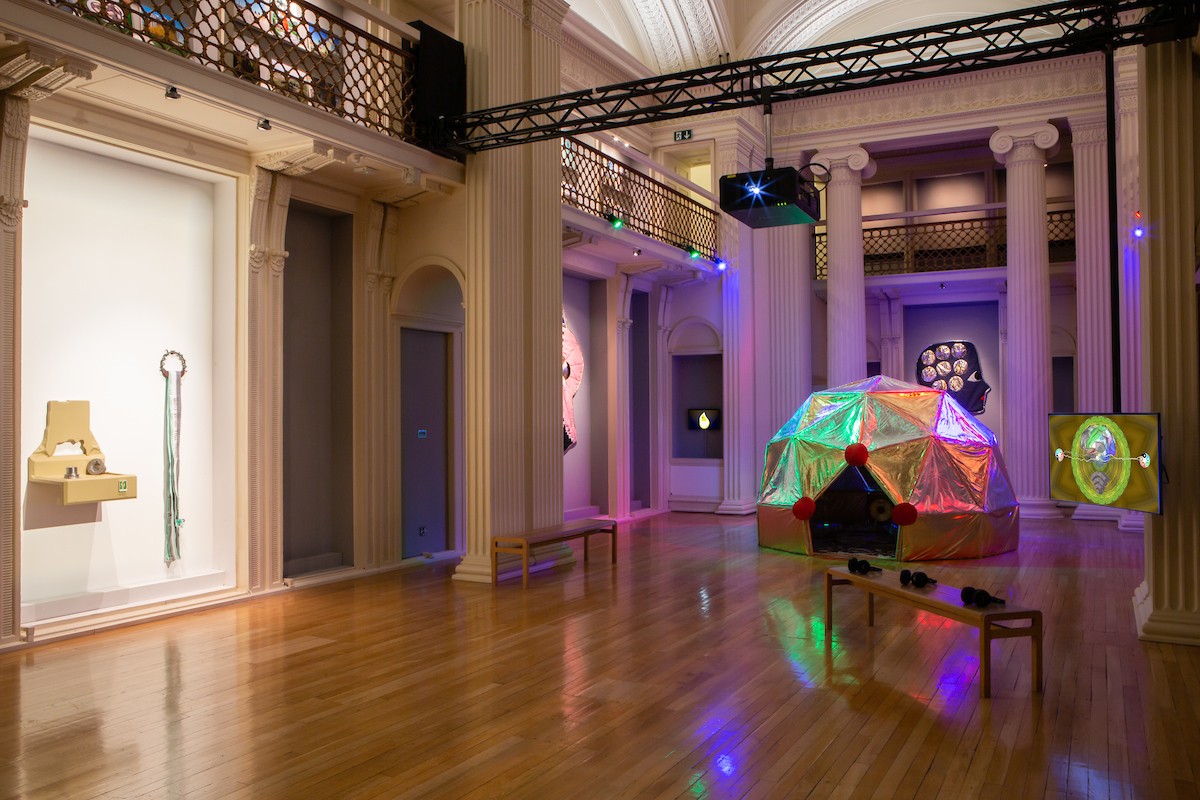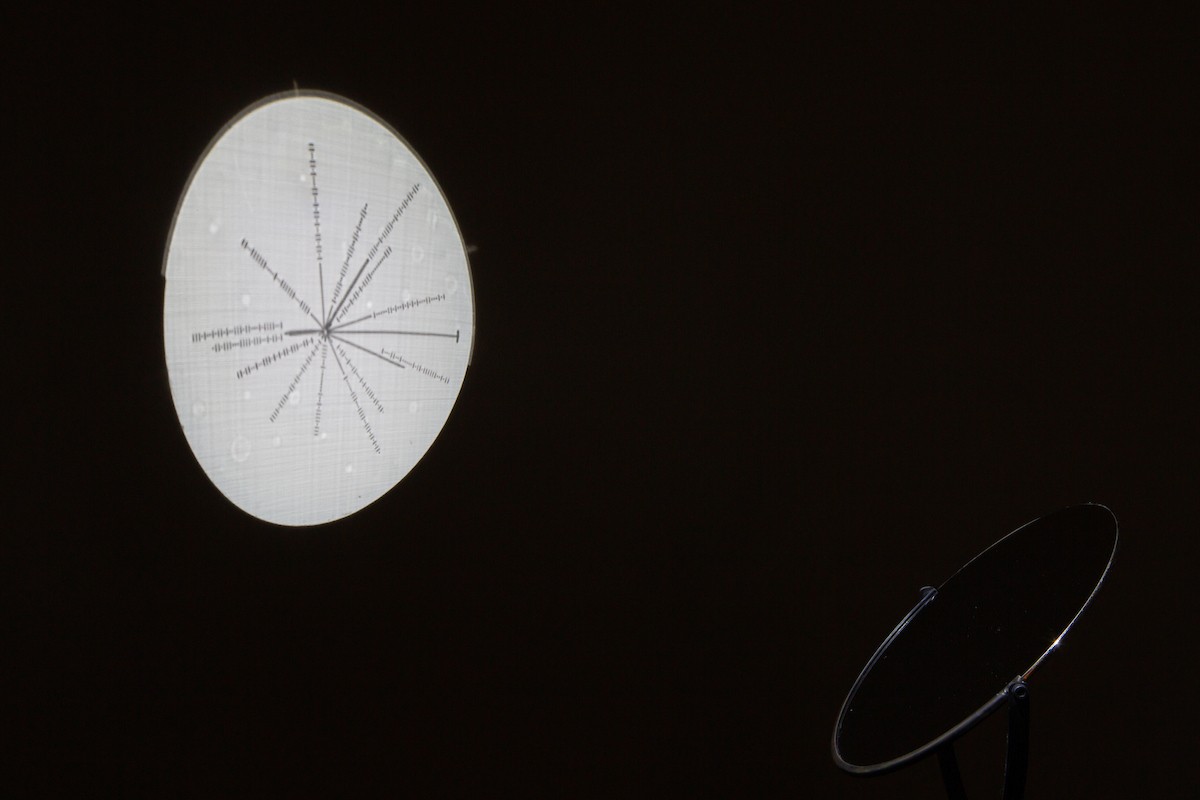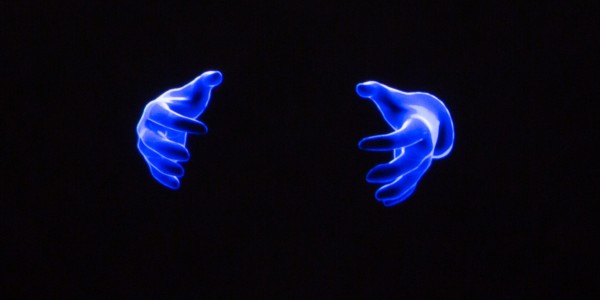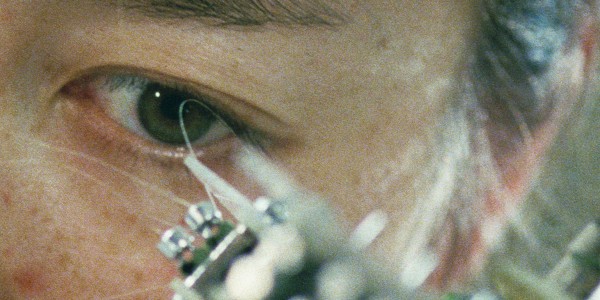The Extended Mind
-

Gianfranco Baruchello, Marcus Coates, Marjolijn Dijkman, Nikolaus Gansterer, Joseph Grigely, Agnieszka Kurant & John Menick, Myriam Lefkowitz, Daria Martin, William McKeown, Goro Murayama, Angelo Plessas, Magali Reus
'The Extended Mind' proposes that our mind – that is our thoughts, reasoning, perception, imagination, intelligence, emotion and experience – is not simply contained within our brains. These things all take place through our bodies and the broader world, enabled by all the tools, technologies, institutions, materials and techniques we might use to orientate our understanding of ourselves.
From shadow puppetry of extinct animals, to videos exploring the impact of electromagnetic waves on our thoughts and cultures, to robots that learn through contact and the idea that digital technology is driving us towards a new collective sense of self, 'The Extended Mind' is set across a diverse series of journeys to other real and imagined places.
Curated by Miranda Anderson, Tessa Giblin and James Clegg.
'The Extended Mind' is funded by The Arts and Humanities Research Council (AHRC). Myriam Lefkowitz's off-site project Walk, Hands, Eyes (Edinburgh) is funded by Creative Scotland.
Share
Listen to short lectures about The History of Distributed Cognition
Featured in the learning space of The Extended Mind exhibition, these short (4 min) lectures aim to give you a sense of the key ideas driving the research that underlies the exhibition. Part of our collaboration with academics from The History of Distributed Cognition project they are written by Michael Wheeler, Douglas Cairns, Miranda Anderson and Mark Sprevak and voiced by Roger Burroughes.
The Extended Mind Activity Pack
A guide for children to the ideas of distributed cognition and activities related to artworks in the exhibition.
Joseph Grigely | Artist Talk
Exhibition Guide
Published on the occasion of 'The Extended Mind' at Talbot Rice Gallery, The University of Edinburgh. With contributions from Tessa Giblin, Director of Talbot Rice Gallery; James Clegg, Assistant Curator; Dr. Miranda Anderson, Anniversary Research Fellowship at Stirling and Honourary Fellow, School of History, Classics & Archaeology, University of Edinburgh and Professor Michael Wheeler, Philosophy, University of Stirling.
The Exhibition Guide is available to view below or download. A large print guide is also available to download.
Curator's Introduction | Miranda Anderson, James Clegg and Tessa Giblin Talbot Rice Gallery and The History of Distributed Cognition
'The Extended Mind' is based on the idea that our bodies, objects, language, institutions, other people and environments, expand our capacity to think, feel and orient ourselves in the world. This idea, that cognition is not simply something that takes place in the brain, is often called distributed cognition. A curatorial and academic endeavour, the exhibition grows from a collaboration between Talbot Rice Gallery and a research project called The History of Distributed Cognition.
The History of Distributed Cognition (2014-2018) aimed to show the relevance of distributed cognition to the arts and humanities. It revealed links to practices and ideas throughout Western Europe, from classical antiquity through to the twentieth century. The Extended Mind exhibition asks how this relates to contemporary art practice. Across the work of 12 international artists it includes videos of robots that learn through embodied interactions; sculptures that reveal our cognitive relationship with objects; critical engagements with technocratic forms of anonymous and distributed labour; vicarious trips to the Amazon jungle; and artificial intelligence and spiritualist responses to the internet age. It invites you on journeys to other real and imagined places, demonstrating how art plays a vital role in scaffolding new forms of understanding.
Alongside 'The Extended Mind' we are also delighted to be presenting 'Walk, Hands, Eyes (Edinburgh'). This is an ongoing performative walking practice devised by French artist and choreographer Myriam Lefkowitz. It has been performed around the world for more than ten years – in Paris, Medellin, Venice, New York and Dhaka – and is never twice the same.
Over the course of an hour’s silent walk a participant and a guide form an immersive relationship with their surroundings. The participant has their eyes closed, but is asked at times to briefly open them to create a surprising perspective of the city. It is a unique and special experience that complements the aims of The Extended Mind.
'The Extended Mind' is funded by the Arts and Humanities Research Council under the broader project heading, The Art of Distributed Cognition (2019-20). 'Walk, Hands, Eyes (Edinburgh)' is supported by Creative Scotland.
Share

Magali Reus
'On Alligator', 2016; 'Propeller E.K.', 2016; 'Sentinel (Adder)', 2017
Magali Reus makes sculptures that reconfigure familiar objects, estranging the things that usually and invisibly help us travel through or moderate our environment. The two series of works in 'The Extended Mind' explore the apparatus of travel and fire safety equipment respectively.
From one series, 'Propeller E.K.' and 'On Alligator' include sculptural elements that are evocative of saddles. The details within the works are embossed with motifs that refer to transportation and movement – and they are fabricated using techniques used in industries such as motorcycle design and saddle making. Imperceptible forms of travel are also referenced, the side panel of 'Propeller E.K.' derived from outmoded ventilations units – alluding to the travel of a more elusive body, namely that of hot and cold air. But – as is typical of Reus’ enigmatic sculptures – the artworks ultimately offer an excess of information that resist any easy interpretation. Reus’ objects are always familiar; they feel like they are on the cusp of being recognizable but then seem to retreat at the last moment. The relationship between the two works in this series establishes a correspondence across which we might start to form comparisons. Indeed, there is a gently instructive quality to Reus’ work, where commonplace objects describe thematic connections and threads. They are nevertheless inscrutable, and they frustrate attempts to apply any one narrative to them. The saddle shapes suggest the body and remind us of the action of riding, giving their static frames a certain onus akin to an animal carrying our weight, whilst they remain functionless. It is to this in-between place Reus leads us.
From another series, 'Sentinel (Adder)' evokes objects that are designed to watch over our safety: objects, such as fire hoses, that we are prone to ignore except in an emergency. In this work, the amorphous wall unit seems to be not quite fully formed in the world, its bulkiness suggesting a container that is then appropriated as a shelf for the hydrant nozzles, conspicuously removed from the hose. A sense of embodiment is brought into play by objects that we know to touch, in this case, hand-sized objects that we would usually rely upon to function in an orderly, predicable, and reliable fashion. The matchbox- like element affixed to the front appears like a logo, but signals the absent function of this work.
The materiality of Reus’ work is of central importance. In this case, the hose was developed by Reus with a specialist weaving factory in Holland and machine embroidered with the title of the piece. Industrial manufacturing often helps the object to be uncanny – removed from the familiar marks of handmade objects – whilst the diverse materials and processes can, in her own words, ‘communicate, in terms of touch and also in terms of history. They can establish emotional connections, or reflect the more performative or functional aspects of the object.’
Philosophers working on distributed cognition, often drawing on the phenomenological tradition, have observed that unhindered expert performance with familiar tools or technology is characterized by a kind of disappearance of the artefacts in question from conscious experience. For example, while engaged in trouble-free text editing, the skilled typist has no conscious recognition of the keyboard, the mouse or the monitor, but rather sees ‘through’ them to the task at hand. This smooth, transparent coping with familiar technology is taken, by some advocates of the extended mind theory, to indicate that the equipment in question has been incorporated into our psychological mechanisms – maybe, in a sense, into our very bodies. However, when technology breaks or malfunctions and thus presents a barrier to skilled activity, it is no longer transparent to its user, but reappears in consciousness. No longer part of our psychological or bodily being – of our extended mind – it is made strange to us, becoming a thing about which we may reflect and reason. Reus too disrupts the transparency of familiar technology and thereby reveals the dynamic of extension and non-extension. Everyday artefacts are made strange through their recontextualization by and within the artworks. Reus’ pieces thus prompt reflection on the function of artefacts within our distributed cognitive lives. The immediate, everyday associations the viewer finds themselves making regarding the elements in question are disturbed, and the capacity of the object to resist fluid incorporation is thereby exposed.

Nikolaus Gansterer
'Following the Fold', 2019; 'untertagüberbau', 2017
Austrian artist Nikolaus Gansterer uses drawing, videos and installations to explore the movements and entangled relations between thinking, drawing and knowing.
'Following the Fold' is a new installation for Talbot Rice Gallery that incorporates Gansterer’s 3-channel video installation 'untertagüberbau'. Both works build on the artist’s long-term fascination with diagrams, maps, networks and other graphical systems that enable us to structure and communicate ideas. For Gansterer, these systems are the fundamental building blocks for any form of cultural exchange. As he wrote for the publication 'Drawing a Hypothesis' (an interdisciplinary project Gansterer co-ordinated with artists, scientists and creative writers):
"The pool of diagrammatic images, signs and symbols is a permanent part of our daily perception. The cognitive act of perceiving, translating and allocating occurs continuously when we compose thoughts and receive or process information. This process of sense-making always happens by establishing relations and through drawing connections: the structures of the semantic relationships embodied in the anatomical organisation of our brains allows us to interact with others by means of language and behaviour and is a diagrammatic operation per se ... From my perspective, the genesis of ideas is often directly connected with graphical thinking..."
In this way Gansterer comes at ideas central to 'The Extended Mind'. His work recognises that our minds are structured both by abstract concepts and by embodied and situated experiences. Emphasised in his moving-image work he shows these operations are fluid – always shifting and reshaping like the living systems they are supported by. Introducing the body through the use of hands – often manipulating thick, viscous materials – their animated characteristics also speak of the cognitive role of time and transition: the mind extends across time as well as space. Elements are continuously remade and reformed.
The use of specific signs and symbols derives from a process Gansterer terms a ‘translecture’. Meeting with people or listening to them talk about a particular subject, he will draw and operate with objects and materials creating constantly shifting ad-hoc diagrams as he listens, in order to make visible and feel out the ideas that fleetingly come to mind. The way in which sketching itself forms part of the process of thinking has been used as an example for the extended mind theory. As Andy Clark put it in 'Natural-Born Cyborgs': "the iterated process of externalizing and re-perceiving turns out to be integral to the process of artistic cognition itself." The role of other people in constituting ideas speaks too of the socially extended nature of the mind. 'Following the Fold' was made whilst Gansterer was listening to various talks and lectures available on the internet about space-time relationships, string theory, quarks, anti-matter, black holes, mirror neurons and theories of mind. As he states, "I find this liminal zone very inspiring where (hard) science facts melt into speculative fabulation, where science turns into fiction, science = fiction."
'untertagüberbau' derives from scientific radio programmes and conjures the sense of laboratories, measurements, charts and graphs – interrupted by living creatures such as snails. More than just a disruption, such living entities make evident the fleshy material basis of the abstract systems – snails, in particular, leave trails of chemical information in their slime, interpretable by those snails which follow after them (as well as easing their progress; a physical equivalent to the easing of the cognitive load by laying down intellectual pathways). Gansterer subjects works to re-evaluation, or commissions others to reinterpret his diagrams and symbols, enabling them to take on the shifts and variegation of complex and multifaceted language systems. They are intended to provide people with a relationship to the process of meaning-making rather than the making of specific meanings.

William McKeown
'Untitled', 2009-2010
'Untitled', 2008
The paintings of William McKeown blur distinctions between different categories, his depictions of the light of the sky during moments of heightened emotional reflectiveness being suspended between subjective and objective categories.
"It is the most extraordinary thing that the light from the sun rolls over the horizon every morning. It makes everything else happen. It is endlessly engaging, irrational, exquisitely beautiful and it happens for absolutely no reason. Watching the sun come up makes you happy inside. It’s that simple. It’s like it comes up for you. It is something we are encouraged to ignore, because you can’t make money from someone who is simply watching the sun come up. If you have a symbiotic relationship with nature and the nature within you, it is the way to happiness, as opposed to the capitalist idea of happiness which is about consumerism."
Growing up on a farm, McKeown fondly remembered experiences that made him feel connected to nature. His paintings, when not untitled, either allude to nature ('The Concrake' or 'The Hayfield') or the feelings it can engender ('Hope Painting' or 'Forever Painting'). At once, they are rooted in reality and in the realm of possibility and freedom that such a reality can make us feel. Whilst not explicitly political, McKeown’s insistence that good art was also always open and non-judgmental, carries with it a profound sense of liberation from cultural, political or emotional constraints.
One way of thinking about the mind views thought and experience as essentially a matter of building internal representations of the world. These internal representations may take many forms: pictures in our consciousness, sentences in a language of thought, patterns of neural activation in our brain that ‘light up’ on MRI scans, and so on. This way of looking at the mind considers cognition to be a process in which such representations are constructed, retrieved, manipulated and transformed. 'The Extended Mind' is informed by research that rejects this approach to thinking about the mind, or at least also emphasises other processes underlying our cognition. Distributed cognition locates thought and experience partly outside the head as a kind of historically structured, skilful knowledge of how to navigate actual or potential sensory patterns and interactions. For example, you experience a tomato as a three-dimensional object, even though you only see it from its facing side, not because you have a complete model of a tomato in your head, but because you have implicit, embodied knowledge of the kinds of experiences you would receive if you were to walk around it or turn it around.
McKeown’s works in this exhibition reward the distributed cognition explanation of the mind while extending its application. Saying that the viewer builds models of McKeown’s paintings in their heads (even models with accompanying subjective commentaries) falls far short of capturing the manner in which these paintings draw the viewer into the unique spaces that are created between the works and themselves. Unlike the everyday case of seeing a tomato, one’s historical experience of objects and events in the world is at best an imperfect guide to the ambiguous encounter offered by McKeown. This allows the experience to be characterized by a sort of positive uncertainty that engenders a profound sense of reaching beyond the mundane. Distributed cognition provides a scientific perspective on this understanding of McKeown’s works.
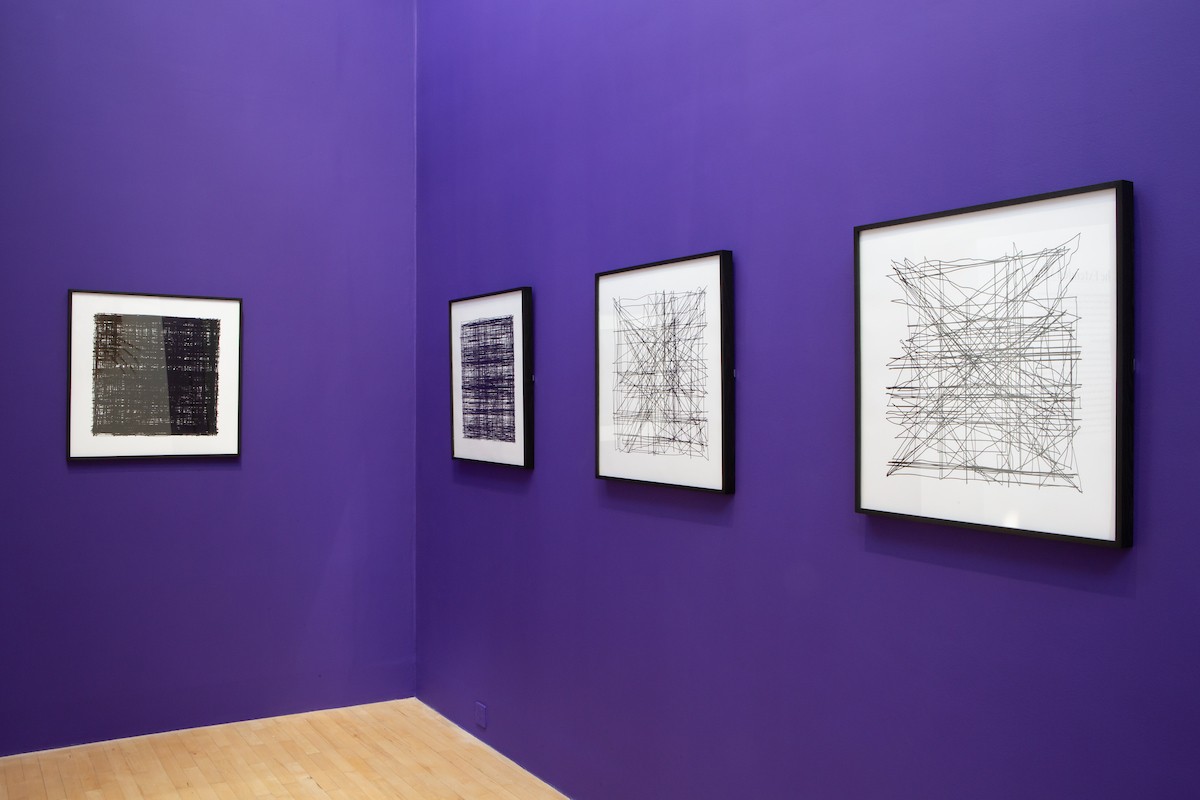
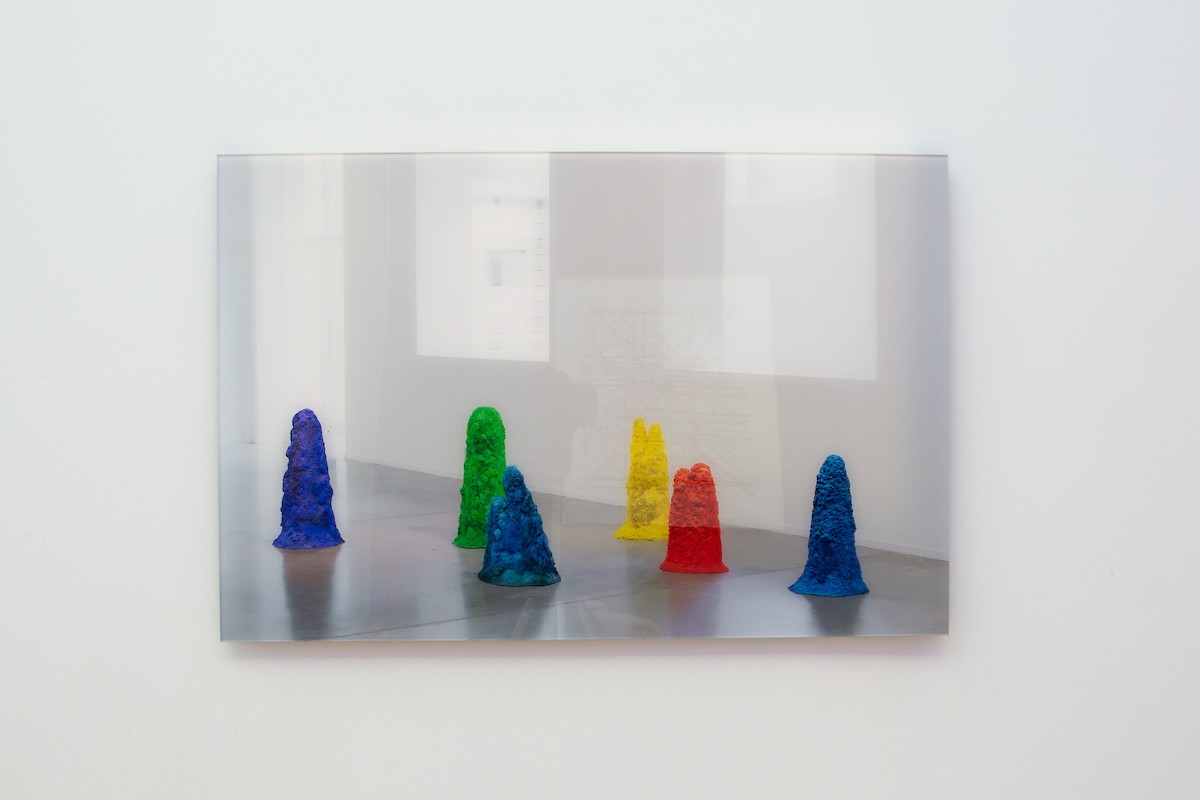
Agnieszka Kurant & John Menick
'Production Line', 2015-ongoing
Agnieszka Kurant
'A.A.I.' [photographic representation], 2019
Working across media, Polish-US artist Agnieszka Kurant has explored the various consequences of advanced capitalism while investigating the phenomenon of collective intelligence in nature and culture.
'A.A.I.' is a photographic representation of a sculptural series in which termites build their mounds from highly coloured commercial sand, gold and crystals. These synthetic looking structures, effectively built ‘blind’ by the termites, become symbols for our own ‘blind’ contribution to the accumulation of capital. The title derives from the very same concept of ‘artificial artificial intelligence’ that underlies 'Production Line', a collaborative work made with artist John Menick that utilises Amazon Mechanical Turk (AMT). This is a crowd-sourcing system that remotely employs people to undertake routine tasks that are often performed more effectively by human beings than they are by computers. Wanting to find out how collective intelligence might relate to artistic production, and considering how to divert some of the art market’s excessive capital into this new emerging online working class, Kurant and Menick employed Turkers (as the anonymous human workers are known). They asked them to draw a simple line from one side of the screen to the other with a computer mouse, starting where the line drawn by the previous worker ended. An algorithm assembled all the individual contributions up to a pre-set number of lines (here 500, 800, 2000 and 3000 lines) and the resultant image was drawn out with a pen-plotting machine, imitating a hand-drawn effect. Each time a drawing has sold on the art market the profits have been re-distributed among the workers through a bonus scheme.
For Kurant, both works raise questions about collective intelligence and the idea of emergence (when lower-level functions or behaviour produce higher-level structures and patterns that are complex and unpredictable). As Kurant says, "we are all invisible workers of a giant production line dispersed into an entire society. We (our data harvested by corporations) are the new oil." When you are asked online to demonstrate ‘I am not a robot’ you are often required to complete tasks such as locating words, people or objects in photographs or videos. This is a good example of the kind of task with which current artificial intelligence systems struggle and requires application of what Amazon’s founder Jeff Bezos termed, ‘artificial artificial intelligence’ – that is, a human. Kurant and Menick see AMT as indicative of a shift in capitalist relations that seek to exploit social productivity. Turkers can earn less than $1 an hour for their work (80% are based in America) and as part of an anonymous and dispersed labour force of ‘contractors’ they are not protected by laws pertaining to a minimum wage and they are unable to unionise. Their agency is restricted in such a way that, as Kurant puts it, ‘the system has found the perfect worker’. At the same time using AMT to intervene in the art world’s usual mode of operation, the work reveals AMT as an inversion of utopian expectations of a future with artificial intelligence where humans are freed from low-level labour. Instead they present a new form of mass human ‘servitude’, reflecting the root meaning of the word ‘robot’ (derived from ‘robota’, meaning forced labourer in Slavic languages). Karel Čapek adopted the term ‘robot’ in 1920 to refer to synthetic mass-produced workers who rise up against their human creators in his play R.U.R. (Rossum’s Universal Robots), his response to the increasing industrialism of his own age.
When drawing their lines the Turkers did not see any other contributions or know that they were making an artwork, and so the drawings developed in an unplanned fashion; they emerge as the result of a process of collective intelligence that Kurant likens to consciousness. Kurant suggests that in an age of Wikipedia, individual authorship starts to be replaced by complex, collective forms.
Collective Intelligence is evident across all levels in the universe, transcending any boundary between nature and culture: it has been observed in bacteria, slime mould, the flight paths of flocks of birds, social movements or escalations of conflict. In an essay about collective intelligence Kurant proposes that:
"the artificial intelligence artist should be imagined as an emergent complex system of “artificial artificial intelligence,” since using the collective intelligence of crowdsourcing to simulate the non-linear complex system of billions of neurons in a human brain is the closest we can get at this point to simulate the emergence of a single thought or of consciousness in general."
Here Kurant problematizes the default location of thoughts in the brain by suggesting that the collective intelligence of crowdsourcing is our best means of understanding cognition. As Andy Clark and Dave Chalmers put it, "Cognitive processes ain’t (all) in the head!"

Goro Murayama
'Self-organized painting [Excessively]', 2016
'Switched sync cellular automaton [hand drawing]', 2018
'Asynchronous cellular automaton [hand drawing]', 2017
'Self-organized painting [multiple of tree structure]', 2017
Inspired by the concept of autopoiesis, or self-sustaining systems, Japanese artist Goro Murayama creates artworks that evolve – or emerge – from systematic processes, dealing with, in his own words, ‘human creativity in the computer age’.
The starting points for the two drawings in the exhibition were Stephen Wolfram’s study of simple cellular automata to investigate self-organizing behaviour. Cellular automata, which are mathematical idealizations of physical systems, involve rows of cells, each with a value of one or zero. The cell values synchronously evolve in discrete time steps, according to the values of adjacent cells in the previous time step and a set of rules. To produce these drawings Murayama asked people to draw ‘cells’ (represented as ‘/\’) comprised of one of three colours. They then had to continue to grow the pattern below by following a series of pre-determined rules. Murayama observes, ‘Despite the system’s apparent rigidity, human error and difference in style meant that the drawings continued to expand in an idiosyncratic fashion independent of each other.’
‘Systems Art’ was a term associated with artworks that used new technologies or were founded on the idea that artworks are simply information. It accompanied the rise of cybernetics and notions of humans as information-processing systems. Inspired by more recent enactive cognition approaches, Murayama puts into practice concepts of autopoiesis, co-emergence and structural coupling. Enactivism describes cognition as sense-making and emphasises the entanglement of embodiment, experience and environment. Autopoiesis, which can be defined as the capacity for self-creation and self-organization, has been used by enactivists to distinguish living from non-living things. In the case of Murayama, the artworks become a manifestation of a self-sustaining system co-constituted by the artist (or those he has asked to take part in the work), the rules for engage- ment and the material properties of the work.
Murayama has stated: ‘In the world surrounded by computers and AI, the concept of order is important for human beings to reconsider their creativity, because we repeat acts and choices.’ The emergence of variation out of a combination of error and individual expression in an environmental system further invites parallels with Darwinian theories of evolution and epigenetics.
The tapestry works in the exhibition, from Murayama’s Self-organised painting series, emerge little by little through a switching back and forth between constructing a woven element, the canvas, and applying acrylic paint. Like a spider in the process of creating its web, Murayama feels himself attune to (as well as being in tension with) the emergent material he weaves, and uses the weaving of the hemp as a means to regulate his actions, becoming part of the system he is making: ‘The system also keeps on generating myself. Acting makes me.’ The process has itself evolved, as the intention to keep the pieces flat was thwarted by errors that he then realised could be incorporated into the system. The tree and branch like structures of the woven parts speak to the resemblances between biological and artificial systems. As with the drawings, this series reflects on our co-creation of and co-emergence from the wider human systems in which we exist, as well as repre- senting the kind of mental scaffolding that is provided through the accretion of structures over time and which enable as well as constrain the possibility of creativity. Furthermore, Murayama reasons that he composes the work in anticipation of our appraisal of it, as in appraising the work we reflect on his construction of it – we, the audience, are drawn into the circle of sense-making.
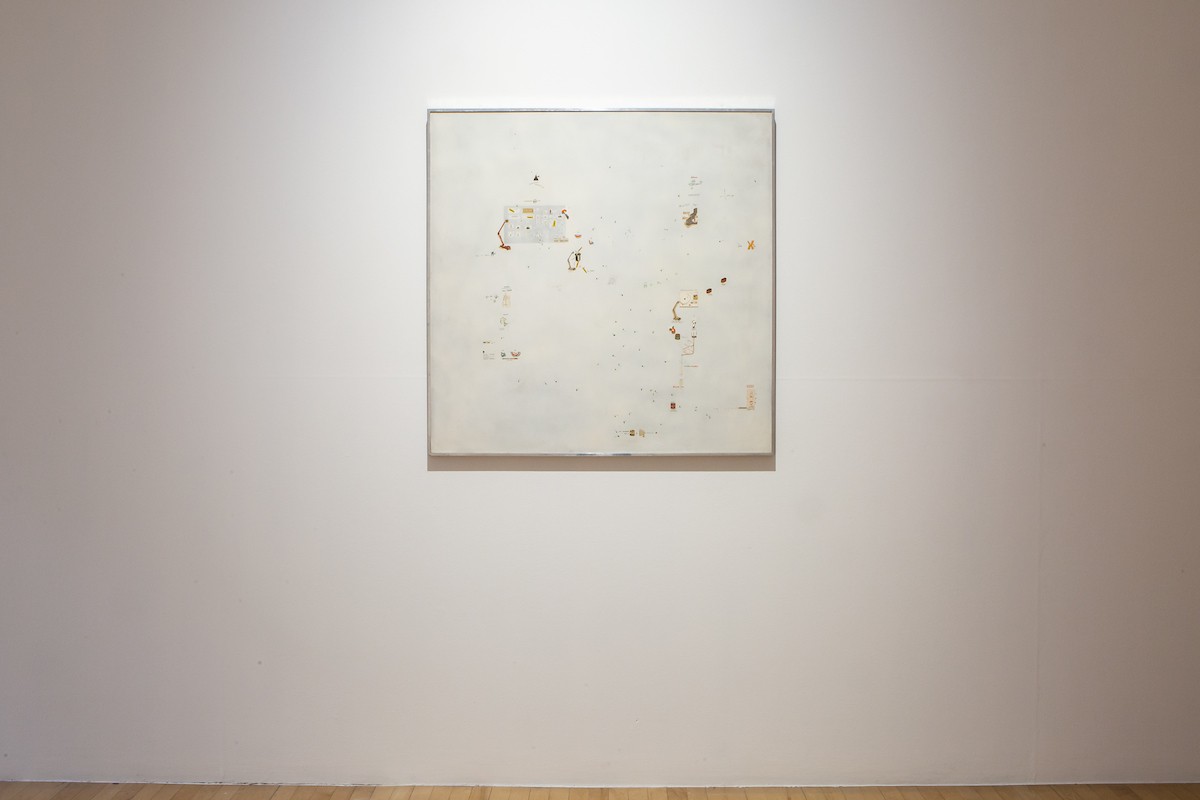

Gianfranco Baruchello
'Agire-da-morto (act-as-a-dead-man-should)', 1967
'Agire-da-morto (act-as-a-dead-man-should)' is indicative of the work of artist Gianfranco Baruchello, who – moving from law, to the bio- chemical industry and eventually to various art forms in the 1960s – developed an idiosyncratic visual painting language, emphasizing chance and free association.
Appearing like maps, diagrams or instructions, Baruchello’s paintings include scraps, inscriptions, trivia and graphics, suggesting unusual connections between various elements. Politically charged, they result from an attempt to describe small, seemingly contradictory systems as a counterpoint to what Baruchello termed the Great Systems, Great Creeds, Great Faiths and ideologies of the twentieth century. Often starting with a consideration of the mechanisms of the human mind and body, he said in an interview in 2012 that:
"The processes of the mind (perceiving, imagining, producing hypotheses) require abandoning stereotypes, overturning conventional logic, putting an end to the system of cause and effect. A new horizon to explore had to comprise that which remains excluded from traditional logic. Processes of the mind can be rethought by reconsidering the arbitrary, the analogous, the ambiguous and the eccentric – all physical and mental excesses."
'Agire-da-morto (act-as-a-dead-man-should)' – like many of Baruchello’s paintings – is comprised of a predominant, white background. This creates a flat surface upon which the elements seem at once free to float around to form new connections and are at the same time subject to some kind of forensic analysis. The title evokes film noir and we are offered a list of ‘cast and characters’, but one comprised predominantly of objects, suggesting that Baruchello is pointing us towards an understanding of a reality in which human agency is embroiled in dynamic mind-world interactions.
One widespread and conventional understanding of thought, as the repeated classification of objects and events constrained by logical transitions, has been rejected within the discourse underlying The Extended Mind. Baruchello’s artworks explore an alternative psychological space of constructive, imaginative association, which is much closer to how many distributed cognition theorists view the processes of reasoning and experience. In this case Baruchello’s paintings function as scaffolds for decentralised and distributed acts of embodied thought. The map-like spatiality of the artworks is a central feature of this process. As we, the viewers, wander visually around the works, the relationships between the scattered text and images, coupled with the workings of our own perceptual, emotional and intellectual mechanisms, allow the various elements to qualify each other (like adverbs qualifying verbs, as Baruchello himself once put it). Providing an alternative model for thought in general, the resulting associative connections are thus dynamic and sometimes chance enactments of meaning; they build contrasting, diverse and essentially incomplete sense-making narratives.


Joseph Grigely
'I don’t want to hear anymore', 2016
Deaf since the age of ten, American artist Joseph Grigely has built his practice around the notes – the external resources – that structure his engagement with hearing people. He creates installations that explore the often-overlooked embodied aspects of human communication, and examine its potential and limitations.
Fifty three years of using these notes have taught Grigely that people love to have their voices heard, and that writing captures many aspects of communication that go beyond the words themselves. As he observed in an essay, these notes reveal that while, ‘The words may seem familiar ... the way that they are put down on paper is not.’
‘Inscribed conversations backtrack, take sudden turns, and stop abruptly. Sometimes there is punctuation; sometimes not. Sometimes there are lines, arrows, and drawings – gestures of the pencil. Sometimes the words are lopsided (it’s really hard to walk and write at the same time). Sometimes there are words on top of words. What makes inscribed conversations particularly important as linguistic artefacts is the way they present both the site and the sight of sound: the site, inasmuch as an otherwise evanescent moment of exchange becomes a material record of that exchange, and the sight, inasmuch as the personality, inflection, and tone of the speaker are revealed by the way the words are written on the page. Human communication is so much more complex than language alone: It also involves the body we put into it.’
Grigely’s notes reflect not only the situated dimensions of the conversation but also signal the invisible aspects of communication that people attempt to embody in the medium of written text. Today, this is a challenge more generally encountered due to the rise of email and texting. These technological developments have led to the proliferation of graphic substitutes, such as emojis, as sense- making aids that act as substitutes for the aural and embodied aspects of interactions. The equivalences and divergences between different forms of communication and their cognitive and subjective effects are probed by the work. It reflects on our use of language as a special ‘mind tool’, as neuropsychologist Richard Gregory termed it, which enables the initial concretisation and communication of an idea, and also on historical attempts when developing written language to compensate for the loss of the immediacy of face-to-face communication.
While the arrangements of these notes have a semblance of order, their geometry serves to bring discrete elements together, suggesting readings that can take any number of directions, just like the conversations themselves. This work can be understood as a means of organising an array of wide-ranging and counterbalanced units of information in a productive, open-ended system. Grigley’s work provides material records of conversations in motion, but leaves open the question as to how the notes being produced may capture, reflect and, in turn, produce the mind. Grigely’s work is a testament to the many ways that working through disabilities can reveal to everyone the unseen and unheard ways we make meaning in the world.
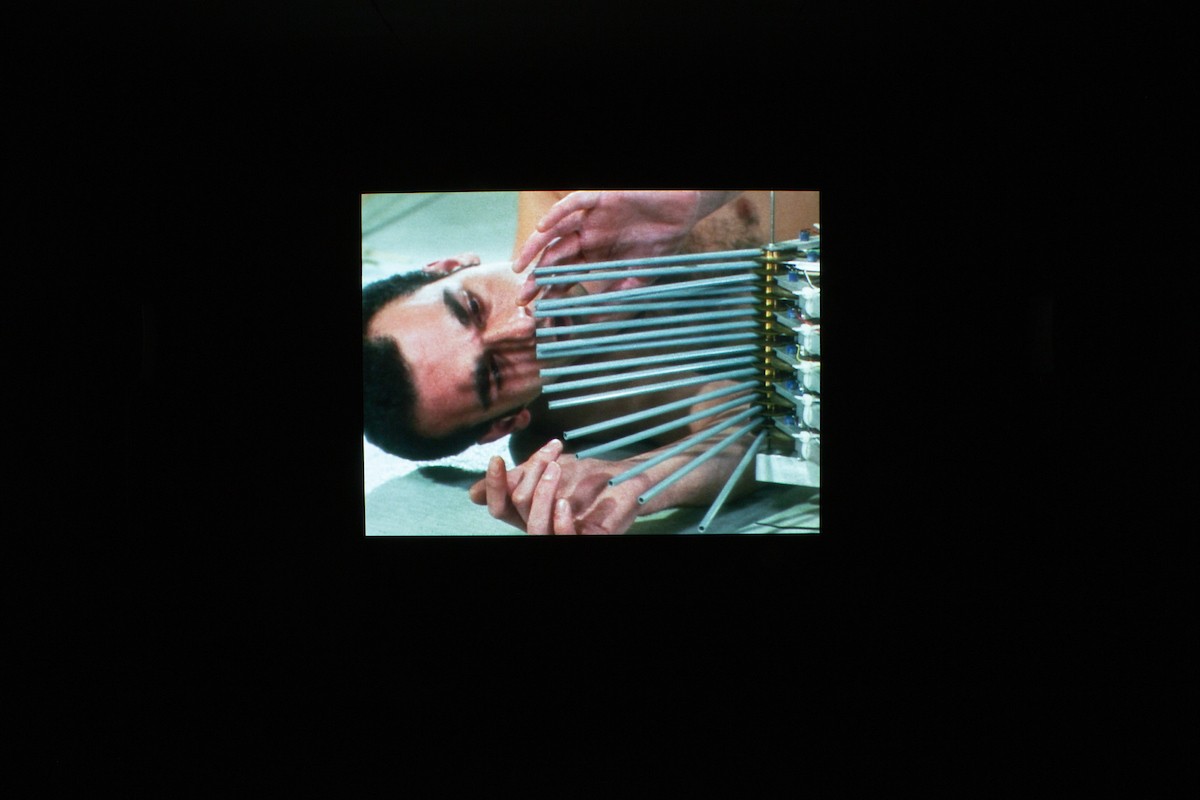
Daria Martin
Soft Materials, 2004
Daria Martin’s work explores mirror-touch synaesthesia, where a person feels the emotional or physical sensations they witness in someone else. In this 2004 work, 'Soft Materials', Martin’s interest in empathy, touch and mirroring is explored through the relationship of dancers and robots.
'Soft Materials' was shot in an artificial intelligence laboratory in Zurich, which at that time focused on embodied artificial intelligence. The robots at the lab were designed to learn through physical experience, rather than being pre-programmed in a top-down way by a computer ‘brain’. In the film they are introduced to a male and female dancer, who sensitively mirror their movements. In Martin’s film, they form reciprocal relationships that suggest an intimacy and coalescence, while emphasising the very different material capabilities of their respective bodies. The sometimes pragmatic and sometimes comical robot names – Eyebot, A-mouse, ADAPT Hand, Dumbo, Stumpy, Blimp Bot – capture a sense of their experimental and diverse forms, each having a capacity to learn that is dependent on their specific mechanical and sensory capabilities.
The team working with Martin at the University of Zurich (Artificial Intelligence Laboratory, Department of Informatics) was highly influential in the ‘turn’ to embodiment in artificial intelligence. In a paper submitted to a conference on embodied intelligence in 2003, Rolf Pfeifer and Fumiya Iida write: "Over the last 50 years Artificial Intelligence (AI) has changed dramatically from a computational discipline into a highly transdisciplinary one that incorporates many different areas. Embodied AI, because of its very nature of being about embodied systems in the real physical and social world, must deal with many issues that are entirely alien to a computational perspective ... physical organisms in the real world, whether biological or artificial, are highly complex and their investigation requires the cooperation of many different areas."
Work on embodied AI and robotics has revealed how sophisticated and difficult-to-recreate are so-called ‘lower-level bodily processes’ and have demonstrated the extent to which environmental factors often scaffold our neural and physical capacities. This is a major shift in the field of robotics. In the second half of the twentieth century, the new field of cybernetics initially claimed that information processing by computers was equivalent to the human mind. Alan Turing’s landmark article, ‘Computing Machinery and Intelligence’ (1950), fostered the paradigm of classical computational theory in which representational symbol structures are transformed by syntactic rules. It is best known through the claim that a universal Turing machine could, like human cognition, perform any well-defined computation through attention only to the form of the problem and without understanding its meaning. More recently, evidence that the cognitive economy also involves and evolves through interactions between the brain, the body and the world led to the shift in thinking about thinking. Here there is an increasing emphasis on developmental relationships, feedback loops and ecological control. A well-known example of the need for such input from the environment is that of the clumsy, heavy and inefficient gait of modern robots – a problem only solved when the role that gravity plays in walking was taken into account.
'Soft Materials' playfully communicates humans’ interactive and adaptive nature: apparent in the film are not only the robots’ adjustments to the dancers, but the dancers’ uncanny capacity to assume congruent motions. It is a dance that illustrates what enactivist Hanne de Jaegher and Ezequiel di Paolo call ‘participatory sense-making’. As well as exploring the intimacy and boundaries between different bodies, the film recalls the question from philosophy, cognitive science and robotics of how much the particular nature of bodies, their fleshy or metal forms, matter. This film makes evident the extendibility and adaptability of humans: information and materiality, representation and enaction, are not in opposition, but collaborate in composing human beings.
Original artwork: 16mm film. Presented here as a digital projection for the purposes of this exhibition.


Marcus Coates
Extinct Animals, 2018; The Trip, 2011
Keen naturalist and ornithologist, artist Marcus Coates is perhaps best known for his shamanistic practice, seeing him descend into the lower world to communicate with animals and retrieve answers to complex social problems. The two more recent works in this exhibition show his continued interest in extra-ordinary encounters.
'The Trip' was filmed in St John’s Hospice, where Coates worked with outpatients between 2009 and 2010 to see if he could put his artistic skills to use on their behalf. Looking through a window in the hospice onto an everyday street scene below, we overhear a conversation between Coates and Alex H., a patient. Coates offers to travel to the Amazon rainforest on Alex’s behalf, taking with him a series of questions to ask the indigenous Waorani people. In the second half of the film Coates returns with the story of his transformative travels, evoking scenes of verdant, strange and yet benign natural habitats and profoundly different cultural perspectives. Not only does Coates offer Alex H. a vicarious, wished-for experience of a place and people, in turn Coates’ experience is shaped by his role as experiencer, seeker and storyteller on behalf of Alex H. The possibility of such two-way phenomenological shaping and sharing across persons, though necessarily constrained, poignantly illuminates our more general human capacity to scaffold and constitute each other’s experiences. The Trip speaks of the vivid sense-evoking capacity of storytelling, one that we the audience, in turn, share through our experience of the film.
In 2017, Coates journeyed to Fogo Island (Canada) to offer an apology to the Great Auk, a flightless bird that became extinct in 1844. Whilst there (in another work) he also imagined himself as the last human on earth, who – despairing – shouts out to convince the land of the importance of human progress.
'Extinct Animals' grew from these projects and carries the same mixture of lament and impotency. Modelled on Coates’ hands, as he attempted to represent the forms of animals made extinct through human activities, they are effectively fossils of a performance; lifeless odes to life. They communicate a sense of abjection that speaks to our failure to embody a harmonious relationship to the natural world.
In his book 'Unconscious Reasoning' (2014) Coates provided insight into the process underlying his long-term practice, as well as practical exercises offering different ways of accessing the unconscious, arguing: ‘The unconscious is constantly working with thousands of memories and experiences, making countless associations between them, converting them into new information: ideas, images, thoughts, sensations and emotions that we can potentially use.’
That our unconscious mind is such a rich repository, signals the fundamental though often unnoticed cognitive roles of our bodies and environments, evidence that important aspects of cognition do not just occur on the level of conscious thought (so it is not necessary for a process to be conscious for it to be counted as cognitive). These works help us imagine distant times and places, whilst leaving so much unseen and unsaid.
Cast from the artist’s hands whilst performing the extinct animal’s shadow:
Labrador duck, Pyrenean ibex, Irish elk, Eastern elk, Auroch, Stellar’s sea cow, Pied raven, Japanese Honshu wolf, Pinta Island tortoise, Atlas bear, Golden toad, Caspian tiger, Barbary lion, Yangtze River dolphin, Syrian elephant, Lake Pedder earthworm, Passenger pigeon, Arabian ostrich.


Marjolijn Dijkman
Mirror Worlds, 2016
Theatrum Orbis Terrarum, 2005-2015
In Our Hands, 2015
Marjolijn Dijkman’s practice turns attention to the human desire for knowledge, often focusing on the points where culture meets other fields of enquiry, combining speculation with science and considering both future and past possibilities. Dijkman illuminates and interrogates the power of artefacts to scaffold knowledge by making works that bridge expanses of time as well as distance.
'In Our Hands' shows two large virtual hands making symbolic gestures designed to predict, remedy or ward off the future, which are taken from various sources including spiritual and military sign systems.
The soundtrack for Dijkman’s video includes binaural tones based on somewhat dubious scientific attempts to use sound waves to influence brainwaves, in this case supposedly creating euphoria. The ambivalence of the work - being both ominous and welcoming - speaks to anxieties around artificial intelligence and its relationship to embodied experience. Within the research underlying 'The Extended Mind', the idea that cognition is both constructed and communicated through our gestures is important. Gestures can be seen, they form shapes and trajectories, and they are felt as a material embodiment
of thought by both the speaker and the observer through motor resonance in what is termed ‘the mirror neuron system’. Mirror neurons in the motor cortex respond similarly when we see another person performing an action and when we perform the action ourselves.
Our grasp of ideas is embodied and enacted. Historically, gestures were often believed to be more trustworthy than verbal language. In Chirologia (1644), John Bulwer argued that gesture ‘presents the signifying faculties of the soule [sic]’ and is ‘another Tongue, which we may justly call the Spokesman of the Body.’ The uncanny effect created by the depiction of these huge hands without a body, autonomously moving in a black space, also echoes earlier depictions of hands in didactic emblems and paintings, often to represent the hands of God, an omnipotent supernatural force.
Contemporary projects in artificial intelligence like the Human Brain Project aim to one day fully simulate the human brain using computer systems. This however is a very contentious claim, encapsulating one of the most taboo aspects of artificial intelligence, namely the idea that human intelligence can be captured. From a distributed cognition perspective, this issue takes on a very different form. Simulating the human brain on a computer, even if it were possible, would not suffice to ‘capture’ human intelligence, because human intelligence is spread out dynamically over the brain, the non-neural body, and an environment consisting of tools, other individuals, social structures and cultural institutions. In making this point, the aim is not to downgrade the crucial contribution of the brain to intelligence. Rather it is to emphasize that to replicate human intelligence, one would need to replicate not just the brain, but also the external cognitive niches in which thinking and reasoning happen, the designer environments of tools and collective assemblages that, often in combination with culturally transmitted practices, literally transform embodied human thought.
'Theatrum Orbis Terrarum' continues Dijkman’s critical exploration of what can be known or captured. It takes its title from the first modern atlas, an encyclopaedic collection of maps and articles compiled
in 1570 by Abraham Ortelius, a Flemish/Netherlandish collector. At the time, his ‘theatre of the orb of the world’ was thought to be so comprehensive that it equated to total knowledge of the world. Dijkman’s collection of photographs of human dwelling places, taken on travels, works against a Western tendency to imagine that an objective ‘totalising knowledge’ is possible, by highlighting a more subjective, relative, inexhaustible series of subjects. In this special re- alisation of the work for Talbot Rice Gallery, audiences are encouraged to move and re-order the images in relation to a series of categories, emphasising that the storing, evaluating and generating of knowledge is a dynamic process and questioning fixed categories or taxonomies. Dijkman implies that knowledge – like dwelling – is not static, but the result of an ongoing, living relationship to the world.
This conception of knowledge as an open-ended interactive system involves notions of sharing, in terms of human characteristics and needs (for example, in terms of external forms of shelter), and of differences in the form of cultural and subjective perceptions and experiences. This work enables us to actively engage with a representational system that is referenced both to ourselves and to the world. Highlighting how we negotiate with meaning-making systems, the work calls attention to these features of human cognition, illustrating humans’ capacity to redeploy existing structures, generate critical and playful responses, and to create new forms of knowledge that orient perceptions and understanding of the world.
'Mirror Worlds' was made at a time of huge investment into SETI (Search for Extraterrestrial Intelligence), including FAST, the world’s largest – 300 metre wide – radio telescope, completed in China in 2016. Its form was inspired by heliographs, devices developed in the latter half of the nineteenth century that could be used to either reflect and shutter the sun’s light, so as to transmit telegraph signals, or for photographing the sun. In turn they were based on the heliotrope, which its inventor Carl Friedrich Gauss used in one of the first recorded attempts to reach life on other planets (despite its very short range).
This cosmological tool can helpfully be compared with cognitive anthropologist Ed Hutchins’ description of our use of navigation tools in his 1995 book Cognition in the Wild, which developed the theory of distributed cognition in relation to ship navigation. Hutchins argued that the tool itself contains part of the knowledge necessary to perform its function and that thinking is spread across the tool, body, and brain, when the tool is used. (Historically in relation to astronomy, Ptolemy in the second century BCE advised keen astronomers to use astronomical tables and ‘artificial instruments’ rather than just their physical ‘sense instruments’ if they wanted to be sure of the accuracy of their observations and calculations.)
Dijkman’s mirror is also a magic mirror – its surface containing imperceptible variations that produce an image when reflected – once associated with subversive spiritualist pursuits in Japan. The pattern
in 'Mirror Worlds' belongs to the space age and corresponds to the solar pulsar image included on Voyager 1, a map intended to help extraterrestrials to locate Earth. While Voyager 1 has travelled further into space than any other human object, Dijkman understood by working with radio-astronomer Roy Smits, that the pulsar image carried deep into space is in fact incorrect. She corrected this image in Mirror Worlds – not that that will help the extraterrestrial explorers who are trying to find us.
Dijkman’s collage of different spiritual and scientific ideas speaks to our capacity to create cognitive resources that constitute (and further) our fundamental human desire to communicate, and our capacity to imagine other worlds and forms of life. They also reflect on the ultimate relativity, vulnerability and limitations of human comprehension.
Visitors are welcome to reorganise the images in the space.
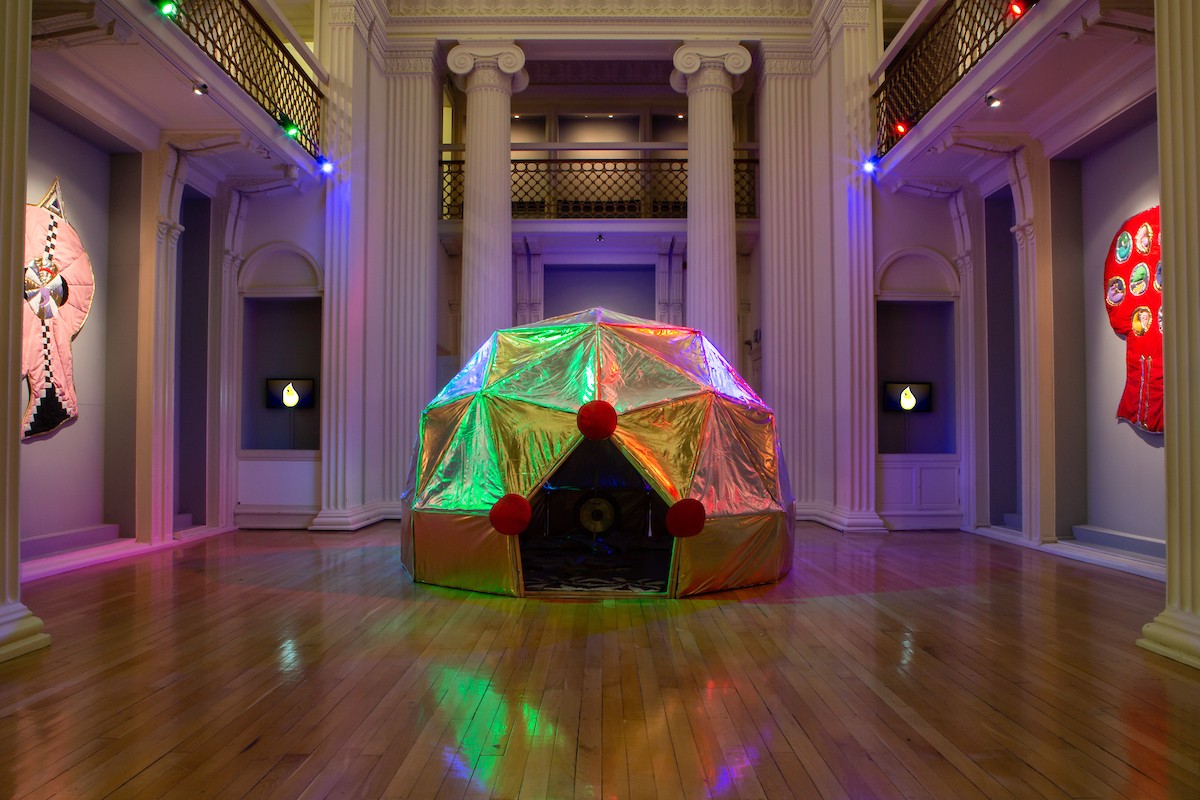

Angelo Plessas
Karma Dome [video], 2019
Karma Dome, 2019
Homo Noosphericus (Science), 2018
Homo Noosphericus (Spirituality), 2018
Homo Noosphericus (Awareness), 2019
DivineLightMission.com, 2019
Creating an immersive installation, Angelo Plessas invites us to consider new forms of consciousness made possible by the Internet, but ones that we are only capable of fully understanding when we remove ourselves from the machinations of capitalist society.
For Plessas, the Internet is an ambivalent force and his work acts accordingly as both a talisman to ward off the malign aspects of technology in the service of capitalism, and as an invitation to celebrate its potential to build a new kind of networked spirituality. Recognising the internet as something that spills into everyday reality, he pushes his practice back and forwards across digital and analogue territories in order to consider changing boundaries and definitions for subjects including considerations of gender and labour.
'Karma Dome', at the centre of the installation, evokes the retreats Plessas organised as part of the Eternal Internet Brotherhood/ Sisterhood project running from 2012 to 2017. Allowing people who have only met online to meet in remote places in the world, these retreats were founded on the premise that we can never undo what the internet has done – that it has profoundly and irrevocably reorganized consciousness – but that the internet can and must be separated from its technocratic effects in order to realise its positive potential. Plessas is concerned that people can become servile to technology and be reduced to machine-like operations, reproducing the algorithms of social media in order to increase the success of a post, for example. As a form of resistance, Plessas adopts various spiritualist theories that promote alternative forms of embodiment and enactment that are resistant to the insidious and reductive logic of capitalism. A video essay in the space offers both context and instruction for using the dome, opening with the statement that:
"The internet spans inside and outside, creating different bioenergetic fields and informational signals that affect the human brain and body. Never before have humans and machines been in such close commune with each other, creating a system of radical applications between us. This horizontal and vertical “collaboration” makes our bodies and minds into readable, recognizable, locatable entities through our devices. We cannot go back to being pre- internet and yet we usually find it difficult to physically function without being online."
The materials surrounding the dome and the three head quilts in the space – 'Homo Noosphericus (Science)', 'Homo Noosphericus (Spirituality)', 'Homo Noosphericus (Awareness)' – are made from materials that can block electromagnetic signals, whilst the dome itself is comprised of materials that are thought to increase positive energies. Plessas describes these energies as ‘orgonic’, following Wilhelm Reich’s debatable theories about life forces. From the scientific perspective of distributed cognition, we might consider the idea of orgonic energy as being a kind of metaphor for how environmental and atmospheric conditions can impact upon cognition, and indeed mental well-being. Whilst karma also sits outside scientific discourses, it could also be understood as a way of trying to make sense of the feedback loops that structure one’s experiences in the world.
Visitors are welcome to remove their shoes and enter the Karma Dome. Please also visit Plessas’s website: DivineLightMission.com
The History of Distributed Cognition
The History of Distributed Cognition project (HDC) demonstrated ways in which different periods and traditions, along with scientific and technological innovations, led to different beliefs and practices of distributed cognition. In regards to art, for example, Renaissance workshops trained apprentices to think with the hand and to adopt the style and perspective of the master painter, with drawings and paintings often collaboratively created. Meanwhile the Surrealists aimed to escape the confines of rational thought by employing materials and methods which took over parts of the creative process from their brains. The research has shown that distributed cognition offers an opportunity to integrate the humanities and the sciences through its understanding that the culturally situated aspects of the mind work in concert with its biological hardware. The HDC team working with Talbot Rice include Miranda Anderson, Douglas Cairns, Mark Sprevak and Michael Wheeler.
Website: www.hdc.ed.ac.uk
Selected works:
Anderson, M. The Renaissance Extended Mind. Basingstoke: Palgrave Macmillan, 2015.
Anderson, Wheeler and Sprevak. ‘Series Introduction: Distributed Cognition and the Humanities.’ Vols. 1-4, The Edinburgh History of Distributed Cognition Series. Edinburgh: Edinburgh University Press, 2018-20, pp. 1-17.
Anderson, Cairns and Sprevak, eds. Distributed Cognition in Classical Antiquity. Edinburgh: Edinburgh University Press, 2018.
Anderson and Wheeler, eds. Distributed Cognition in Medieval and Renaissance Culture. Edinburgh: Edinburgh University Press, 2019.
Anderson, Rousseau and Wheeler, eds. Distributed Cognition in Enlightenment and Romantic Culture. Edinburgh: Edinburgh University Press, 2019.
Anderson, Garratt and Sprevak, eds. Distributed Cognition in Victorian Culture and Modernism. Edinburgh: Edinburgh University Press, 2020.
Wheeler, M. ‘Talking about More than Heads: the Embodied, Embedded and Extended Creative Mind’. Creativity and Philosophy. Ed. B. Gaut and M. Kieran. London: Routledge, pp. 230-50.
Endnotes
Nikolaus Gansterer is quoted from: Gansterer, N. Drawing a Hypothesis, Berlin, Walter de Gruyter GmbH, 2017, pp 20-21. Also from correspondence, with permission of the artist. Andy Clark is quoted from, Natural-Born Cyborgs, Oxford: Oxford University Press, 2003, pp. 37–8.
William McKeown is quoted from: Hancock, C. William McKeown, Dublin, Irish Museum of Modern Art, p. 63.
Agnieszka Kurant is quoted from: Kurant, A. UNCOMPUTABLES, Cabinet (Issue 61), Pp 51-59. Also from correspondence, with permission of the artist. Andy Clark and David Chalmers, ‘The Extended Mind’, Analysis 58.1, p.8.
Goro Murayama is quoted from: Murayama, G ‘Artist Talk: System as Medium and System as Motif, Goro Murayama’ The Daiwa Foundation, 18 April 2018, (https://www.youtube.com/ watch?v=Dxjb25iJpmw).
Gianfranco Baruchello is quoted from an interview with Angelo Capasso in Flash Art: Flash Art, International Edition (Vol. XLV, No. 287). Available at https://flash---art.com/article/gianfranco- baruchello/ [accessed 11/10/2019].
Joseph Grigely is quoted from: Grigely, J: On deaf ears: Joseph Grigely on Sanford Friedman’s Conversations with Beethoven, Artforum International(Vol. 53, Issue 9.), 2015.
Iida, F, Pfeifer, R, Steels, L., Kuniyoshi, Y in Fumiya Iida Rolf Pfeifer Luc Steels Yasuo Kuniyoshi (eds.) Embodied Artificial Intelligence, Germany, Springer, p. v.
Marcus Coates is quoted from: Coates, M. Unconscious Reasoning, London, Bookworks, p. 7.
Angelo Plessas is quoted from the transcript of Karma Dome [video] 2019.
Key Ideas
Distributed cognition draws on ideas in philosophy, cognitive science, psychology, linguistics and neuroscience that attribute cognitive roles to the brain, body and world. Since it accords cognitive roles to the body and world, the perspective it provides on the mind and human nature is more inclusive and encompassing than depictions of the mind in Cartesian, neurocentric or postmodern theories. Distributed cognition is not one single theory, but instead covers an intertwined group of competing and sometimes conflicting theories, which also are known collectively as ‘4E cognition’:
Embodied cognition: cognitive states and processes are routinely shaped in fundamental ways by bodily forms, movements, states and processes.
Embedded cognition: external resources (such as tools or technology) act as noncognitive aids to an internal thinking system located in the brain; so, while the external resources enable cognition, they are not themselves counted as cognitive.
Extended cognition: a coupled system of external resources, bodily movements and in-the-head processing constitutes the thinking agent; all of these factors count as cognitive.
Enactive cognition: cognition is enacted (unfolds) through looping sensorimotor interactions between the agent and its environment, implying a close relationship between perception and action.
All four Es feature a social dimension, as thought and experience often depend, in complex ways, on the external ‘resources’ provided by other people, social structures and cultural institutions.
The multifaceted nature of distributed cognition as a theory reflects the operation of different cognitive norms and modes in the world. Different cognitive models come to the fore in relation to different mental capacities or shifting contexts. An emphasis on the role of embodiment, for example, might emerge due to, or as a reaction against, technological, scientific and sociocultural changes.
'The History of Distributed Cognition' project brought to the fore new or under-explored themes in distributed cognition. Also highlighted was sharing across periods and cultures, particularly in terms of how distributed notions of human cognition are expressed. 'The Extended Mind' features the work of 12 leading international artists, whose works provide new ways of thinking about the relation between mind and world. Their works offer imaginative and diverse reflections on distributed cognition in general and specifically highlight some of the themes that have newly come to the fore through HDC research, such as:
1. Constructed environments are also niches for scaffolding thought.
2. Cognitive science often focuses on distribution as a way of enhancing cognition, but distribution is not always beneficial.
3. Artworks produce new experiences by deliberately using material artefacts to scaffold and interrogate our automatic cognitive and affective responses.
4. Distributed memory is not simply a matter of data retrieval. It is a complex process that involves emotional and symbolic understanding.
5. The creative role of enactive processes in art.
6. Our bodies and technologies help us to achieve new scales and modes of knowledge that are otherwise beyond our comprehension.
This non-exhaustive list indicates just a few of the ways in which the exhibition intends to challenge your beliefs about, and sense of, where your mind ends and the world begins. More generally, the exhibition reveals ways in which artefacts and artworks extend our biological cognitive capacities and draw social culture and the physical and virtual worlds into the creative process. By combining strengths in the arts and humanities with knowledge from the sciences we can imagine and create new ways of understanding our minds and highlight the ways in which artworks and cultural artefacts support and extend our cognitive capacities.
'The Extended Mind' raises awareness of the array of internal and external resources and environments that contribute to the ways we think and (as with the HDC project) importantly brings to the fore some of the personal, political and ethical issues predicated on that realization, whilst also highlighting their relevance to our current time.








